BC
Pipeline Standoff: Wet’suwet’en Block Effort to Tunnel under Morice RiverOn the scene where Coastal GasLink’s plan to install pipe under the river bed has been halted for 11 days.
Amanda Follett Hosgood 4 Oct 2021 | TheTyee.ca
Amanda Follett Hosgood is The Tyee’s northern B.C. reporter. She lives in Wet’suwet’en territory. Find her on Twitter @amandajfollett.
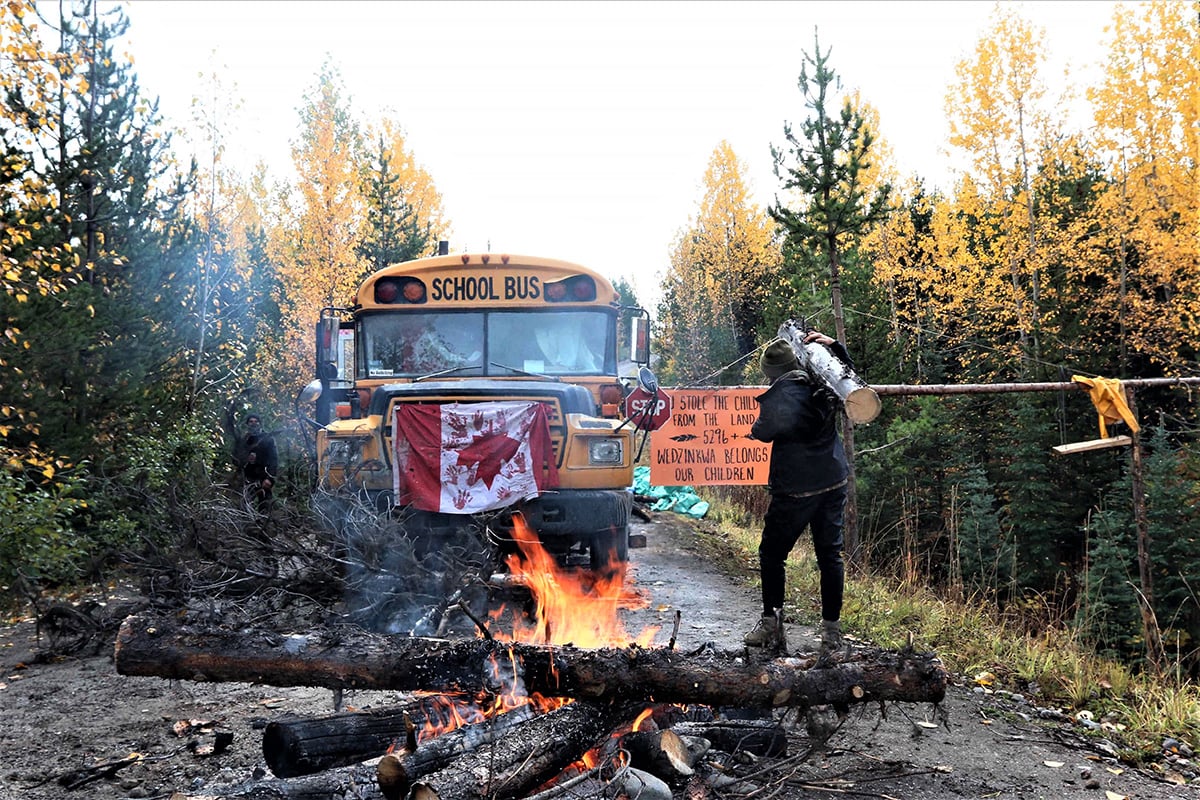
A roadblock preventing Coastal GasLink from accessing a site where it plans to drill under the Morice River, or Wedzin Kwa to the Wet’suwet’en. RCMP have visited the site several times since the camp was created on Sept. 24, making two arrests. Photo by Amanda Follett Hosgood.
At the turnoff, four workers with Coastal GasLink security gather in orange and yellow vests, their voices edged with frustration as they talk above four idling pickup trucks that release a haze of exhaust into the early morning light.
One very lucky Tyee reader will receive full access to the city’s hottest literary event.
Another pickup faces off against the group, blocking access to the rough and muddy spur road that leads to the pipeline worksite.
It’s a scene that has played out every day for the past week and a half on Wet’suwet’en territory, as land defenders block pipeline workers from accessing a site where Coastal GasLink is preparing to drill under the Morice River and install the pipeline.
On Sept. 24, protesters used Coastal GasLink’s own machinery to dig up the rough resource road that connects this junction to a worksite two kilometres beyond. A camp was established at the site and a school bus used to block access. The school bus has since been removed — twice — by RCMP and Coastal GasLink before being returned to its place in the road, which has been roughly repaired by the pipeline company.
Known to the Wet’suwet’en as Wedzin Kwa, the Morice River becomes the Bulkley, eventually flowing into the Skeena River at Hazelton. It’s a major artery through the territory and source of sustenance and tradition for the nation, as well as the territorial boundary between the Gidimt’en Clan’s Cas Yikh house and the Unist’ot’en, a house group belonging to Gilseyhu Clan.
The Tyee is supported by readers like you Join us and grow independent media in Canada
According to Molly Wickham, a Cas Yikh house member whose Wet’suwet’en name is Sleydo’, it was never a question of whether they would fight to protect Wedzin Kwa. Only a question of when.
“It’s always been about Wedzin Kwa,” she says. “Everything that’s happened up until now has been about Wedzin Kwa.”
At the turnoff, four workers with Coastal GasLink security gather in orange and yellow vests, their voices edged with frustration as they talk above four idling pickup trucks that release a haze of exhaust into the early morning light.
One very lucky Tyee reader will receive full access to the city’s hottest literary event.
Another pickup faces off against the group, blocking access to the rough and muddy spur road that leads to the pipeline worksite.
It’s a scene that has played out every day for the past week and a half on Wet’suwet’en territory, as land defenders block pipeline workers from accessing a site where Coastal GasLink is preparing to drill under the Morice River and install the pipeline.
On Sept. 24, protesters used Coastal GasLink’s own machinery to dig up the rough resource road that connects this junction to a worksite two kilometres beyond. A camp was established at the site and a school bus used to block access. The school bus has since been removed — twice — by RCMP and Coastal GasLink before being returned to its place in the road, which has been roughly repaired by the pipeline company.
Known to the Wet’suwet’en as Wedzin Kwa, the Morice River becomes the Bulkley, eventually flowing into the Skeena River at Hazelton. It’s a major artery through the territory and source of sustenance and tradition for the nation, as well as the territorial boundary between the Gidimt’en Clan’s Cas Yikh house and the Unist’ot’en, a house group belonging to Gilseyhu Clan.
The Tyee is supported by readers like you Join us and grow independent media in Canada
According to Molly Wickham, a Cas Yikh house member whose Wet’suwet’en name is Sleydo’, it was never a question of whether they would fight to protect Wedzin Kwa. Only a question of when.
“It’s always been about Wedzin Kwa,” she says. “Everything that’s happened up until now has been about Wedzin Kwa.”
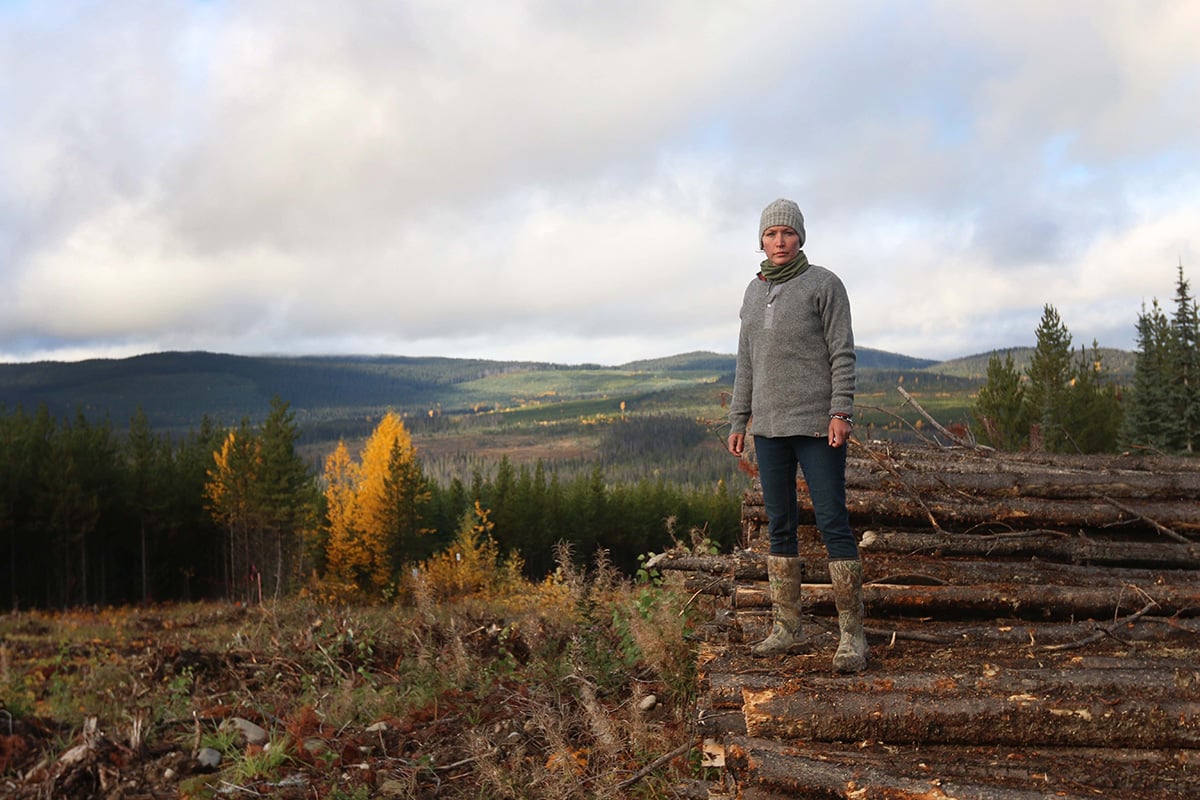
Molly Wickham, whose Wet’suwet’en name is Sleydo’, stands next to Coastal GasLink’s pipeline right-of-way where she and other land defenders have built a camp on Gidimt’en Clan territory.
Photo by Amanda Follett Hosgood.
The current standoff takes place 63 kilometres down the Morice West Forest Service Road south of Houston, B.C., the site of two past police actions. In early 2019, RCMP arrested 14 people, including Wickham, when they raided a roadblock at Kilometre 44, where members of the Gidimt’en Clan had erected a camp to re-occupy the land and keep pipeline workers out.
A year later, in February 2020, four camps along the Morice were raided after Coastal GasLink was granted a permanent injunction to continue its work on Wet’suwet’en territory. The final day of arrests took place at the Unist’ot’en Healing Centre, just a few kilometres from the current roadblock, where Wet’suwet’en resistance to pipelines began more than a decade ago. In total, 28 people were arrested over five days, seven of them at the healing centre.
Police have already arrested two people in the latest standoff. But today, the camp and blockade two kilometres beyond the turnoff from the forest service road are quiet. It’s the first day that RCMP haven’t arrived to read the injunction or threaten arrests, and the land defenders busy themselves working on projects around the camp as a raven hops brazenly nearby, the inquisitive tilt of its head appearing to ask what’s for breakfast.
The camp has been established on a muddy site intended as a helipad next to Coastal GasLink’s right-of-way. The pipeline route, which the company says is more than 90 per cent cleared through this section, extends 670 kilometres from northeast B.C. to Kitimat, where it will connect with LNG Canada’s processing and export facility.
It’s only by walking the right-of-way to where clearing stops about a kilometre below camp that you hear Wedzin Kwa gurgling beyond. Here, the 30-metre-wide route expands several times over, its surface scraped bare and mud threatening to consume a rubber boot. Deer and bear have left their marks in its surface.
It’s here that Coastal GasLink plans to stage its drilling operation, the vast expanse of muck a holding area for lengths of 48-inch pipe. Slash piles and dirt mounds tower several times the height of a person. An abandoned bulldozer sits idly nearby, a sign reading “Active Work Site” appearing to mock the scene
The current standoff takes place 63 kilometres down the Morice West Forest Service Road south of Houston, B.C., the site of two past police actions. In early 2019, RCMP arrested 14 people, including Wickham, when they raided a roadblock at Kilometre 44, where members of the Gidimt’en Clan had erected a camp to re-occupy the land and keep pipeline workers out.
A year later, in February 2020, four camps along the Morice were raided after Coastal GasLink was granted a permanent injunction to continue its work on Wet’suwet’en territory. The final day of arrests took place at the Unist’ot’en Healing Centre, just a few kilometres from the current roadblock, where Wet’suwet’en resistance to pipelines began more than a decade ago. In total, 28 people were arrested over five days, seven of them at the healing centre.
Police have already arrested two people in the latest standoff. But today, the camp and blockade two kilometres beyond the turnoff from the forest service road are quiet. It’s the first day that RCMP haven’t arrived to read the injunction or threaten arrests, and the land defenders busy themselves working on projects around the camp as a raven hops brazenly nearby, the inquisitive tilt of its head appearing to ask what’s for breakfast.
The camp has been established on a muddy site intended as a helipad next to Coastal GasLink’s right-of-way. The pipeline route, which the company says is more than 90 per cent cleared through this section, extends 670 kilometres from northeast B.C. to Kitimat, where it will connect with LNG Canada’s processing and export facility.
It’s only by walking the right-of-way to where clearing stops about a kilometre below camp that you hear Wedzin Kwa gurgling beyond. Here, the 30-metre-wide route expands several times over, its surface scraped bare and mud threatening to consume a rubber boot. Deer and bear have left their marks in its surface.
It’s here that Coastal GasLink plans to stage its drilling operation, the vast expanse of muck a holding area for lengths of 48-inch pipe. Slash piles and dirt mounds tower several times the height of a person. An abandoned bulldozer sits idly nearby, a sign reading “Active Work Site” appearing to mock the scene
.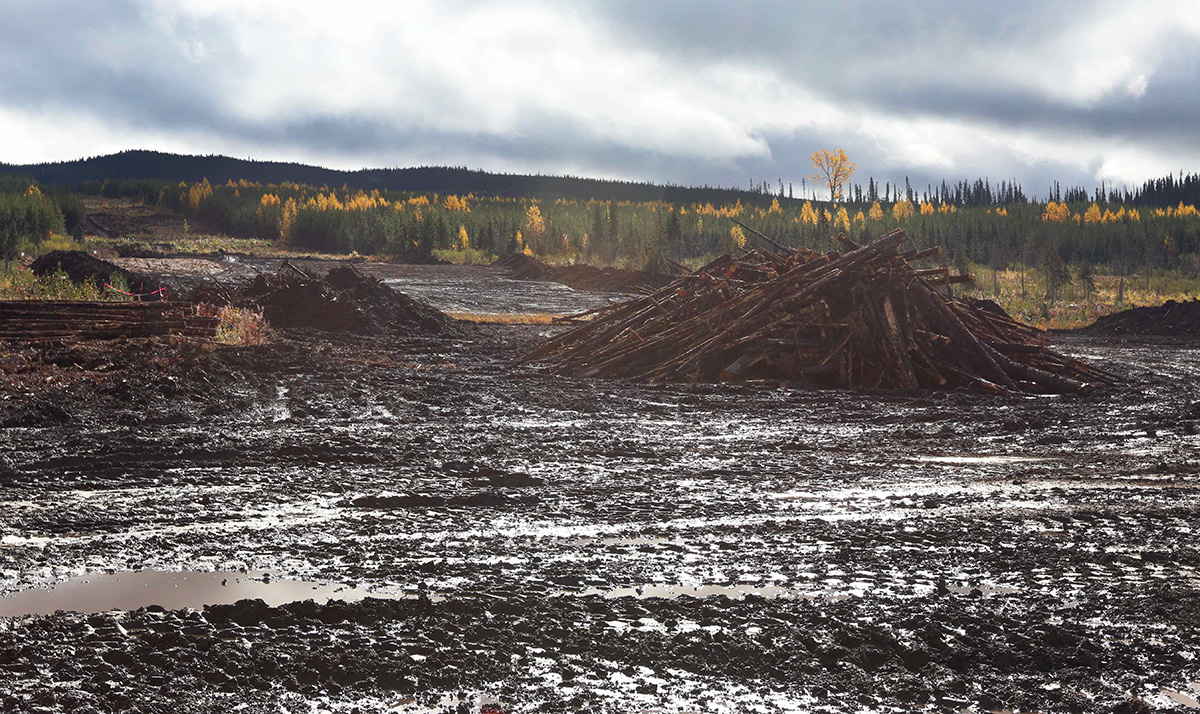

A cleared area several hundred metres wide just above the Morice River, Wedzin Kwa, is intended to store lengths of 48-inch pipe during Coastal GasLink’s drilling process.
Photo by Amanda Follett Hosgood.
Where the clearing ends, a narrow trail begins. It leads to Wedzin Kwa, where the river’s edge is quiet, continuing as it has for millennia. A pair of seagulls dip and dive over the river.
“That’s our main river, Wedzin Kwa. That’s where our salmon are,” Hereditary Chief Na’Moks, John Ridsdale, says about the river’s significance as a food source and lifeblood for the nation. “We’re the Wet’suwet’en. This is who we are — the land, the air and the water.”
In its 135-kilometre journey through the Skeena watershed, the pipeline route crosses 206 watercourses, according to a technical data report submitted as part of its 2014 environmental assessment application, tributaries that offer vital spawning habitat for salmon.
This stretch of river below Morice Lake, Wedzin Bin, “supports important Chinook salmon spawning and holding areas,” according to the data report. Pink, coho and sockeye salmon are also found here, and steelhead and bull trout use the river on their way to spawning channels upstream.
“These areas and other accessible tributaries also provide critical rearing and overwintering habitat for juvenile salmon and resident char and trout,” the report says.
The report indicates there is no low-risk period for working within the waterways. Salmon occupy Wedzin Kwa up to 11 months of the year, and other species fill the mid-summer gap when fry have left their spawning ground in spring and the return of salmon in late summer.
“There are fish of one species or another that are in that waterway at all times of the year,” says Michael Price, a fisheries biologist and researcher with Simon Fraser University who co-authored a sockeye-recovery plan with the Office of the Wet’suwet’en.
Price says sockeye returns in Wedzin Kwa plummeted in the mid-20th century, from an estimated 70,000 a year to an all-time low of about 1,000 in the mid-1950s. Work to recover salmon populations has been ongoing for more than 50 years, with moderate success. By the early 2000s, returns appeared to rebound, levelling off at between 10,000 and 20,000 returning sockeye each year — still well below historic numbers
Where the clearing ends, a narrow trail begins. It leads to Wedzin Kwa, where the river’s edge is quiet, continuing as it has for millennia. A pair of seagulls dip and dive over the river.
“That’s our main river, Wedzin Kwa. That’s where our salmon are,” Hereditary Chief Na’Moks, John Ridsdale, says about the river’s significance as a food source and lifeblood for the nation. “We’re the Wet’suwet’en. This is who we are — the land, the air and the water.”
In its 135-kilometre journey through the Skeena watershed, the pipeline route crosses 206 watercourses, according to a technical data report submitted as part of its 2014 environmental assessment application, tributaries that offer vital spawning habitat for salmon.
This stretch of river below Morice Lake, Wedzin Bin, “supports important Chinook salmon spawning and holding areas,” according to the data report. Pink, coho and sockeye salmon are also found here, and steelhead and bull trout use the river on their way to spawning channels upstream.
“These areas and other accessible tributaries also provide critical rearing and overwintering habitat for juvenile salmon and resident char and trout,” the report says.
The report indicates there is no low-risk period for working within the waterways. Salmon occupy Wedzin Kwa up to 11 months of the year, and other species fill the mid-summer gap when fry have left their spawning ground in spring and the return of salmon in late summer.
“There are fish of one species or another that are in that waterway at all times of the year,” says Michael Price, a fisheries biologist and researcher with Simon Fraser University who co-authored a sockeye-recovery plan with the Office of the Wet’suwet’en.
Price says sockeye returns in Wedzin Kwa plummeted in the mid-20th century, from an estimated 70,000 a year to an all-time low of about 1,000 in the mid-1950s. Work to recover salmon populations has been ongoing for more than 50 years, with moderate success. By the early 2000s, returns appeared to rebound, levelling off at between 10,000 and 20,000 returning sockeye each year — still well below historic numbers
.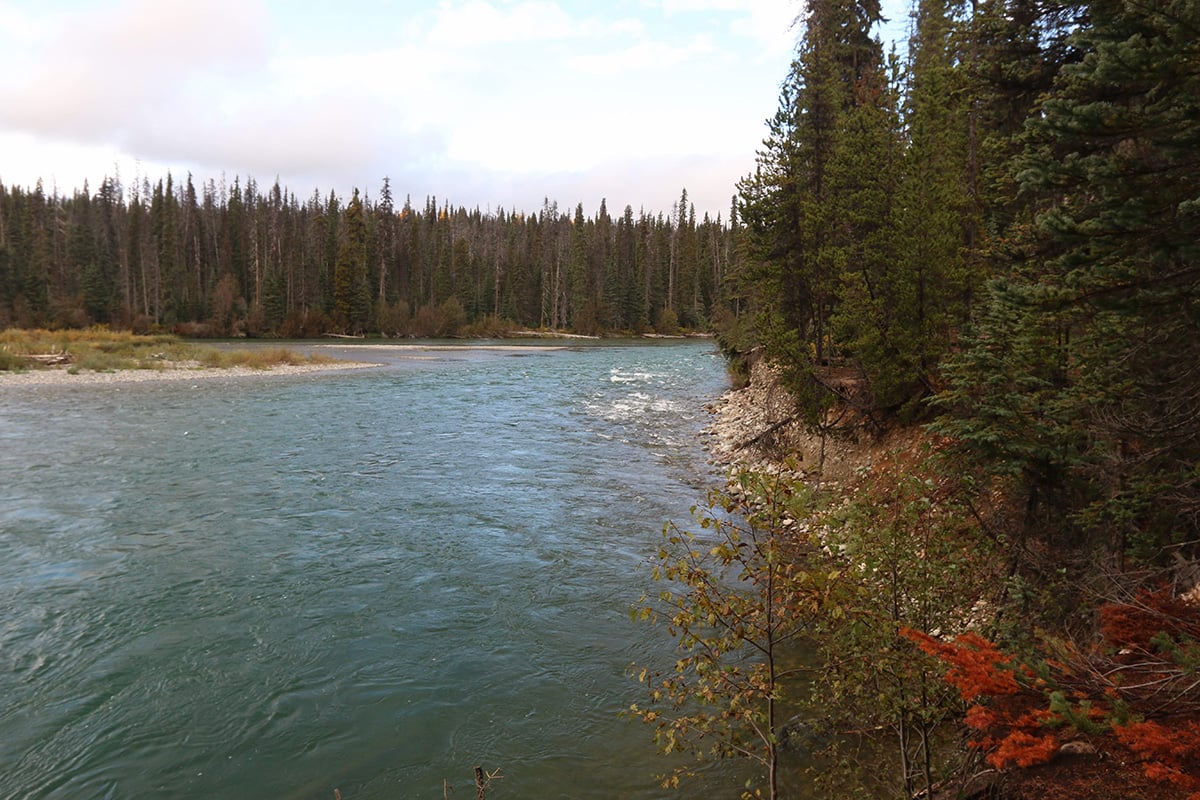

Below Coastal GasLink’s drill site, Wedzin Kwa continues as it has for millennia. ‘This is who we are,’ says Wet’suwet’en Hereditary Chief Na’Moks, ‘the land, the air and the water.’
Photo by Amanda Follett Hosgood.
But even as the nation, in partnership with Fisheries and Oceans Canada, works on a strategy to rebuild salmon stocks, industry continues to impact salmon habitat.
This spring, Wickham says the river’s silty runoff season, when people avoid drinking its water, lasted several months instead of the usual several weeks. She suspects it was the result of industrial logging in the watershed. Trenching through creeks and streams in preparation to lay pipe beneath the riverbed will likely also release silt and sand into the waterway.
“My biggest fear is that we’re never going to be able to drink from Wedzin Kwa again... and that it will impact spawning salmon,” Wickham says.
Price says the continued effects on the watershed — things like habitat destruction, overfishing and climate change — act as a “death by a thousand cuts.”
“Fish need cold, clean, contaminant-free water. Whenever you have industrial projects that take place in or near water, there’s a high potential for damage,” he says.
“I’m amazed that a project like this has been allowed to go ahead given that there’s at least one endangered population of salmon up there. There’s a rebuilding plan that Fisheries and Oceans was part of, and we can’t even stop an industrial project like this from taking place.”
But even as the nation, in partnership with Fisheries and Oceans Canada, works on a strategy to rebuild salmon stocks, industry continues to impact salmon habitat.
This spring, Wickham says the river’s silty runoff season, when people avoid drinking its water, lasted several months instead of the usual several weeks. She suspects it was the result of industrial logging in the watershed. Trenching through creeks and streams in preparation to lay pipe beneath the riverbed will likely also release silt and sand into the waterway.
“My biggest fear is that we’re never going to be able to drink from Wedzin Kwa again... and that it will impact spawning salmon,” Wickham says.
Price says the continued effects on the watershed — things like habitat destruction, overfishing and climate change — act as a “death by a thousand cuts.”
“Fish need cold, clean, contaminant-free water. Whenever you have industrial projects that take place in or near water, there’s a high potential for damage,” he says.
“I’m amazed that a project like this has been allowed to go ahead given that there’s at least one endangered population of salmon up there. There’s a rebuilding plan that Fisheries and Oceans was part of, and we can’t even stop an industrial project like this from taking place.”

Workers with Coastal GasLink security placed an orange T-shirt, symbolic of Indigenous children who died at residential schools, at the junction of Morice West Forest Service Road and a spur road leading to a pipeline worksite. Photo by Amanda Follett Hosgood.
In an email to The Tyee, Coastal GasLink says it’s not required to limit work on river crossings to least-risk windows — June and July — under its environmental assessment application if it’s using trenchless crossings, where a tunnel is bored below the river rather than disturbing the riverbed.
The company says its plans to use micro-tunnelling, which uses a hydraulic jack to force pipe into the ground behind the boring machine, is “the most precise and state-of-the-art” drilling method available. The almost 900-metre span is expected to take 10 months to complete, the company says. It did not respond to The Tyee’s question about how deep the drilling would go.
This is the only trenchless crossing in Wet’suwet’en territory.
“Nothing like that’s ever happened along that river system, ever,” Chief Na’Moks says about the company’s plans to drill under Wedzin Kwa. He says something as simple as a bridge constructed over a river can be enough to keep salmon from migrating upstream.
A hereditary Chief recently met with the BC Oil and Gas Commission and Ministry of Energy and Mines to request a moratorium on the drilling, he says. When asked about the request, the Oil and Gas Commission says that any changes in the project’s timeline are up to Coastal GasLink.
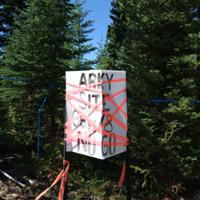
‘If They Destroy This, They’re Wiping Us off This Territory
In an email to The Tyee, Coastal GasLink says it’s not required to limit work on river crossings to least-risk windows — June and July — under its environmental assessment application if it’s using trenchless crossings, where a tunnel is bored below the river rather than disturbing the riverbed.
The company says its plans to use micro-tunnelling, which uses a hydraulic jack to force pipe into the ground behind the boring machine, is “the most precise and state-of-the-art” drilling method available. The almost 900-metre span is expected to take 10 months to complete, the company says. It did not respond to The Tyee’s question about how deep the drilling would go.
This is the only trenchless crossing in Wet’suwet’en territory.
“Nothing like that’s ever happened along that river system, ever,” Chief Na’Moks says about the company’s plans to drill under Wedzin Kwa. He says something as simple as a bridge constructed over a river can be enough to keep salmon from migrating upstream.
A hereditary Chief recently met with the BC Oil and Gas Commission and Ministry of Energy and Mines to request a moratorium on the drilling, he says. When asked about the request, the Oil and Gas Commission says that any changes in the project’s timeline are up to Coastal GasLink.

‘If They Destroy This, They’re Wiping Us off This Territory
’READ MORE
It’s unlikely that Coastal GasLink would voluntarily agree to further delays. The project has been plagued with cost overruns and setbacks, largely due to protests and the pandemic. The delays have led to tensions with LNG Canada.
With drilling already a year behind schedule, Wickham speculates the company is feeling anxious to regain access and begin the work.
“They cannot afford this conflict or any delays,” she says.
Wickham says the land defenders’ ability to delay the project is a testament to the strength of these occupations, which have been backed by hereditary Chiefs from all five Wet’suwet’en clans, and sends a cautionary tale to industry attempting to work in Indigenous territories without explicit consent.
“What happens here is going to set a precedent for all other industries that want to trespass on our land without free, prior and informed consent from our hereditary governance system,” Wickham says. “Industry needs free, prior and informed consent from Indigenous people.”
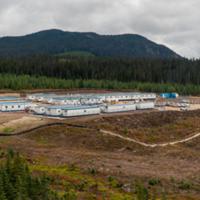
Coastal GasLink Spills More Contaminants in Wet’suwet’en Territory
It’s unlikely that Coastal GasLink would voluntarily agree to further delays. The project has been plagued with cost overruns and setbacks, largely due to protests and the pandemic. The delays have led to tensions with LNG Canada.
With drilling already a year behind schedule, Wickham speculates the company is feeling anxious to regain access and begin the work.
“They cannot afford this conflict or any delays,” she says.
Wickham says the land defenders’ ability to delay the project is a testament to the strength of these occupations, which have been backed by hereditary Chiefs from all five Wet’suwet’en clans, and sends a cautionary tale to industry attempting to work in Indigenous territories without explicit consent.
“What happens here is going to set a precedent for all other industries that want to trespass on our land without free, prior and informed consent from our hereditary governance system,” Wickham says. “Industry needs free, prior and informed consent from Indigenous people.”

Coastal GasLink Spills More Contaminants in Wet’suwet’en Territory
READ MORE
Coastal GasLink did not address The Tyee’s questions about the delays, project timelines or how significant the current setback is for the project, saying only that progress continues with almost 50 per cent of construction complete. It has already done five trenchless crossings of other rivers, it says.
Back at the turnoff, the workers, who say they are with Coastal GasLink security, have hung an orange shirt from a pylon next to the road. On the eve of Canada’s first Reconciliation Day, the symbol recognizes Indigenous children who were forcibly taken from their families, many of whom died at residential schools.
When approached, the workers pull out video cameras and decline to answer questions.
A fifth man arrives in another pickup, wearing an identical orange T-shirt. When asked about the shirt’s message, his response is brisk.
“To show our support for the missing children,” he says, edging toward his vehicle as he speaks. “We all have children and we all know. That’s why we’re doing it. Just to show support.”
The man declines to give his name.
Coastal GasLink did not address The Tyee’s questions about the delays, project timelines or how significant the current setback is for the project, saying only that progress continues with almost 50 per cent of construction complete. It has already done five trenchless crossings of other rivers, it says.
Back at the turnoff, the workers, who say they are with Coastal GasLink security, have hung an orange shirt from a pylon next to the road. On the eve of Canada’s first Reconciliation Day, the symbol recognizes Indigenous children who were forcibly taken from their families, many of whom died at residential schools.
When approached, the workers pull out video cameras and decline to answer questions.
A fifth man arrives in another pickup, wearing an identical orange T-shirt. When asked about the shirt’s message, his response is brisk.
“To show our support for the missing children,” he says, edging toward his vehicle as he speaks. “We all have children and we all know. That’s why we’re doing it. Just to show support.”
The man declines to give his name.
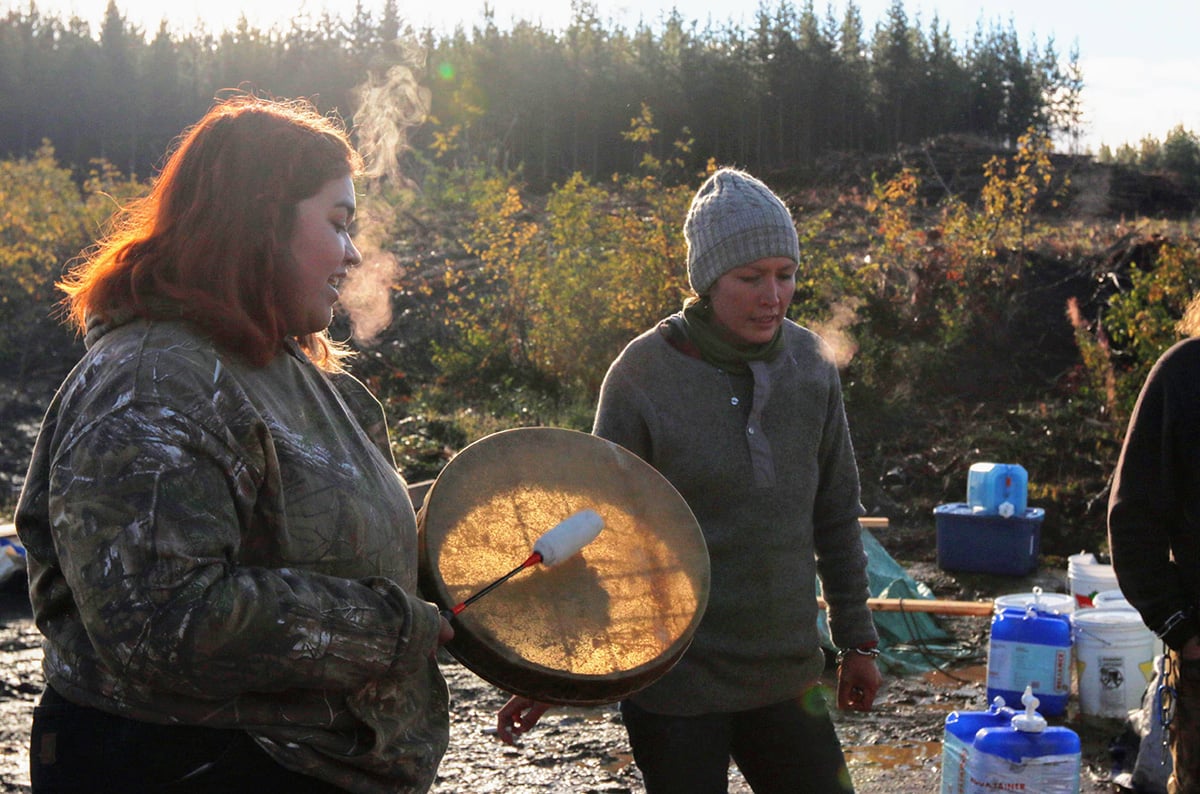
Shaylynn Sampson, from the Gitxsan Nation, drums as she and Molly Wickham, who carries the Wet’suwet’en name Sleydo’, sing together at a camp designed to block access to Coastal GasLink workers.
Photo by Amanda Follett Hosgood.
Back at camp, Wickham is thinking about her own children and their future here on the territory. It’s been a week in camp and she doesn’t know when she’ll see her family. It all seems really crazy, she acknowledges, recalling a recent moment when she left her cabin in the dead of night.
As she stared into the darkness, her headlamp beam caught the nearby right-of-way, its trees razed by machinery.
“And I was like, no, that’s crazy,” she says.
“I feel like it’s so normalized to see the destruction of the land that it doesn’t feel absurd to people... What we’re doing should be normal and destruction of the land should not be what seems normal.”
Back at camp, Wickham is thinking about her own children and their future here on the territory. It’s been a week in camp and she doesn’t know when she’ll see her family. It all seems really crazy, she acknowledges, recalling a recent moment when she left her cabin in the dead of night.
As she stared into the darkness, her headlamp beam caught the nearby right-of-way, its trees razed by machinery.
“And I was like, no, that’s crazy,” she says.
“I feel like it’s so normalized to see the destruction of the land that it doesn’t feel absurd to people... What we’re doing should be normal and destruction of the land should not be what seems normal.”

No comments:
Post a Comment